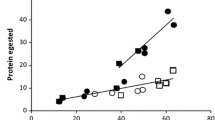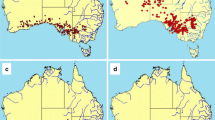Abstract
Five groups of E. blakelyi seedlings were differentially fertilized to obtain a range of N concentrations from 0.8–3.0% dry wt in the foliage. Groups of P. atomaria larvae were reared from eclosion to the prepupal stage on these seedlings. The effects on larval growth and development caused by foliar concentrations of N, moisture content, and tannins and leaf toughness were measured. Pupal dry weight and development time of P. atomaria did not differ between those reared on foliage with N levels of 1.7–3.0% but there was a significant decrease in pupal weight and increase in development time for individuals fed foliage with N below this level. Larvae fed foliage with an average of 0.8% N died before reaching instar III. Total dry matter consumption increased with a decrease in N concentration. Larval nitrogen utilization efficiency increased as foliar N level decreased until N reached a level somewhere between 1.7%–1.2% below which it decreased. There appeared to be an N concentration threshold above which P. atomaria larvae received adequate N by regulating consumption and nitrogen utilization efficiency but below which they could no longer accumulate enough N by compensation to maintain an optimum growth rate and development time. Effects of food quality variables on relative growth and consumption rates are presented and discussed.
Similar content being viewed by others
References
Ashton DH (1975) Studies of litter in Eucalyptus regnans forests. Aust J Bot 23:413–433
Baker JG (1975) Protein utilization by larvae of the black carpet beetle, Attogenus megatoma. J Insect Physiol 21:613–621
Bernays EA (1981) Plant tannins and insect herbivores: an appraisal. Ecol Ent 6:353–360
Carne PB (1966) Ecological characteristics of the eucalypt-defoliating chrysomelid Paropsis atomaria 01. Aust J Zool 14:647–672
Cromer RN (1971) Fertilizer trials in young plantation eucalypts. Aust For Res 5:1–10
Denno RF, McClure MS (1983) Variable plants and herbivores in natural and managed systems. Academic Press, NY, p 712
Feeny PP (1968) Effects of oak leaf tannins on larval growth of the winter oak moth Operophtera brumata. J Insect Physiol 14:805–817
Feeny PP (1970) Seasonal changes in oak leaf tannins and nutrients as a cause of spring feeding by winter moth caterpillars. Ecol 51:565–581
Fox LR, Macauley BJ (1977) Insect grazing on Eucalyptus in response to variation in leaf tannins and nitrogen. Oecologia (Berlin) 29:145–162
Hedin PA (ed) (1983) Plant resistance to insects. Amer Chem Soc, Wash DC Symp Ser 208, p 375
House HL (1965) Effects of low levels of nutrient content of a food and of nutrient imbalances on the feeding and the nutrition of a phytophagous larva, Celerio euphorbiae (Linnaeus) (Lepidoptera: Sphingidae). Can Ent 97:62–68
Journet ARP, Cochran PM (1978) Free amino acids in the leaf tissue of Eucalyptus blakelyi. Phytochem 17:1789–1790
Lamb D (1976) Variations in the foliar concentrations of macro and micro elements in a fast-growing tropical eucalypt. Plant and Soil 45:477–492
Lowman MD, Box JD (1983) Variation in leaf toughness and phenolic content among five species of Australian rain forest trees. Aust J Ecol 8:17–25
Marascuilo LA (1971) Statistical methods for behavioral science research. McGraw-Hill, San Francisco, p 578
Mattson WJ (1980) Herbivory in relation to plant nitrogen content. Ann Rev Ecol Syst 11:119–161
McClure MS (1980) Foliar nitrogen: A basis for host suitability for elongate hemlock scale, Fiorinia externa (Homoptera: Diaspididae). Ecol 61:72–79
McNeill S, Southwood TRE (1978) The role of nitrogen in the development of insect/plant relationships. In: Harborne JB (ed) Biochemical aspects of plant and animal coevolution. Phyto Chem Soc Eur Symp Ser 15:77–98
Miles PW, Aspinall D, Correll AT (1982) The performance of two chewing insects on water-stressed food plants in relation to changes in their chemical composition. Aust J Zool 30:347–355
Montgomery ME (1982) Life-cycle nitrogen budget for the gypsy moth, Lymantria dispar, reared on artificial diet. J Insect Physiol 28:437–442
Morrow PA, Fox LR (1980) Effects of variation in Eucalyptus essential oil yield on insect growth and grazing damage. Oecologia (Berlin) 45:209–219
Myers JH (1981) Interactions between western tent caterpillars and wild rose: A test of some general plant herbivore hypotheses. J Anim Ecol 50:11–25
Myers JH, Post BJ (1981) Plant nitrogen and fluctuations of insect populations: A test with the cinnabar moth-tansy ragwort system. Oecologia (Berlin) 48:151–156
Ohmart CP, Stewart LG, Thomas JR (1983) Leaf consumption by insects in three Eucalyptus forest types in southeastern Australia and their role in short-term nutrient cycling. Oecologia (Berlin) 59:322–330
Schonau APG (1981) Seasonal changes in foliar nutrient content of E. grandis. South Afr J For 119:1–4
Schultz JC, Baldwin IT, Nothnagle PJ (1981) Hemoglobin as a binding substrate in the quantitative analysis of plant tannins. J Agr Food Chem 29:823–826
Scriber JM (1978) The effects of larval feeding specialization and plant growth form on the consumption and utilization of plant biomass and nitrogen: An ecological consideration. Entomol Exp Appl 24:294–510
Scriber JM (1979) Effects of leaf-water supplementation upon postingestive nutritional indices of forb, shrub-, vine-, and treefeeding Lepidoptera. Entomol Exp Appl 25:203–215
Scriber JM, Slansky F Jr (1981) The nutritional ecology of immature insects. Ann Rev Entomol 26:183–211
Slansky F Jr, Feeny PP (1977) Stabilization of the rate of nitrogen accumulation by larvae of the cabbage butterfly on wild and cultivated food plants. Ecol Monogr 47:209–228
Tabashnik BE (1982) Responses of pest and non-pest Colias butterfly larvae to intraspecific variation in leaf nitrogen and water content. Oecologia (Berlin) 55:389–394
Taylor WE, Bardner R (1968) Leaf injury and food consumption by larvae of Phaedon cochleariae (Coleoptera: Chrysomelidae) and Plutella maculipennis (Lepidoptera: Plutellidae) feeding on turnip and radish. Entomol Exp Appl 11:177–184
Viser JH, Minks AK (1982) Proceedings of the 5th International Symposium on Insect-Plant Relationships. Wageningen, the Netherlands 1–4 March 1982. Wag Centre Agr Publ Doc, p 464
Waldbauer GP (1968) The consumption and utilization of food by insects. Adv Insect Physiol 5:229–289
White TCR (1969) An index to measure weather-induced stress of trees associated with outbreaks of psyllids in Australia. Ecol 50:905–909
White TCR (1974) A hypothesis to explain outbreaks of looper caterpillars, with special reference to populations of Selidosema suavis in a plantation of Pinus radiata in New Zealand. Oecologia (Berlin) 16:279–304
White TCR (1976) Weather, food and plaques of locusts. Oecologia (Berlin) 22:119–134
White TCR (1978) The importance of a relative shortage of food in animal ecology. Oecologia (Berlin) 33:71–86
Author information
Authors and Affiliations
Rights and permissions
About this article
Cite this article
Ohmart, C.P., Stewart, L.G. & Thomas, J.R. Effects of food quality, particularly nitrogen concentrations, of Eucalyptus blakelyi foliage on the growth of Paropsis atomaria larvae (Coleoptera: Chrysomelidae). Oecologia 65, 543–549 (1985). https://doi.org/10.1007/BF00379670
Received:
Issue Date:
DOI: https://doi.org/10.1007/BF00379670




